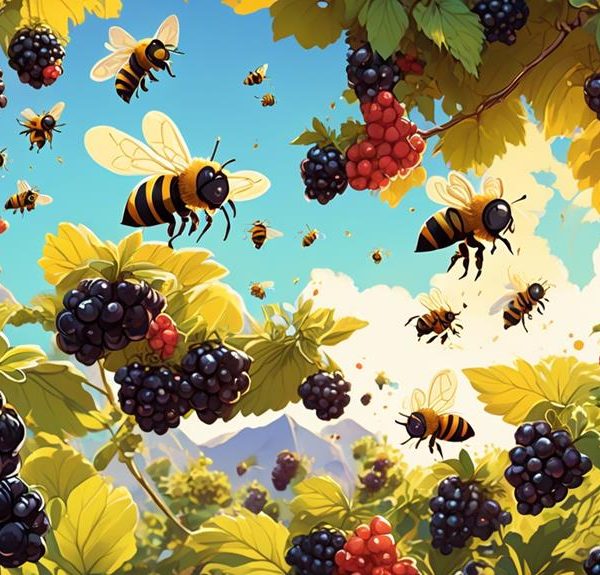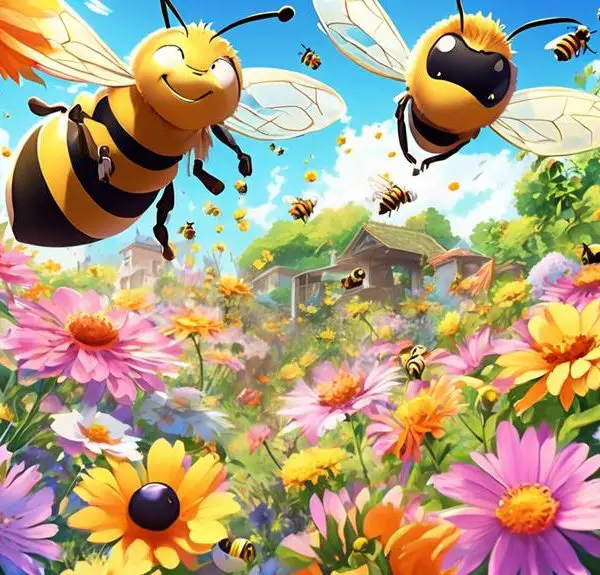Hover into the world of bees and blanket flowers, uncovering the mysterious connection between these vibrant blooms and industrious insects.
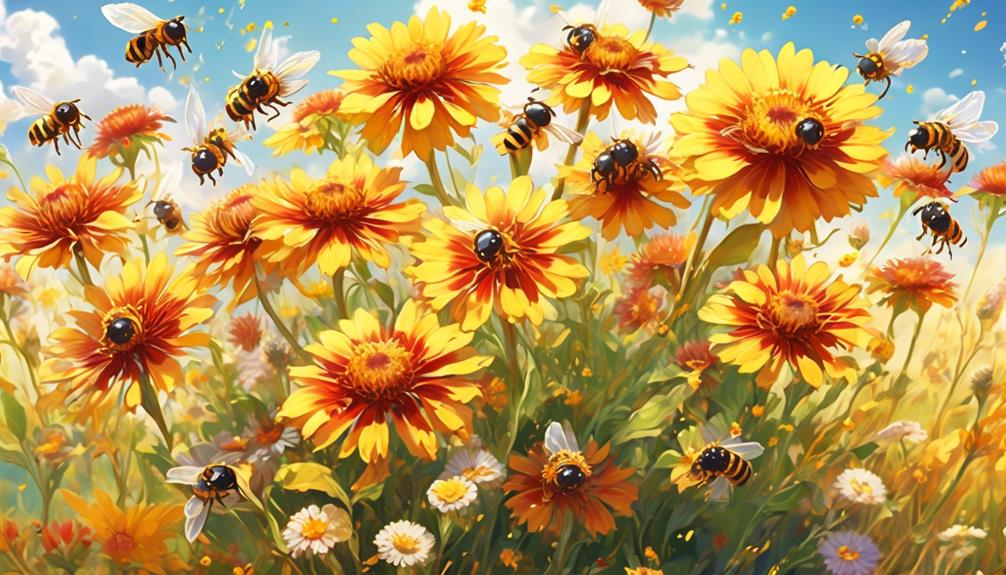
Do Bees Like Blanket Flower
You might be wondering if bees have a special fondness for the visually striking blanket flower. This is certainly a topic that could spark a lively conversation among gardeners and bee enthusiasts alike.
As you venture into the world of blanket flowers and their potential allure for bees, it's important to consider both the bees' natural preferences and the specific characteristics of these vibrant flowers. While there's no definitive yes or no answer, exploring this subject could shed new light on how you plan your garden or understand these industrious insects.
So, why not take a moment to explore this intriguing intersection of botany and entomology?
Key Takeaways
- Blanket flowers, scientifically known as Gaillardia, have characteristics that make them highly attractive to bees.
- Bees are naturally drawn to the vibrant colors, rich nectar supply, and easy landing platforms provided by blanket flowers.
- The Gaillardia genus is among the top ten most visited by bees, indicating their preference for these flowers.
- Planting blanket flowers can help boost bee populations, provide a consistent food supply, and contribute to biodiversity and ecosystem health.
Understanding the Blanket Flower
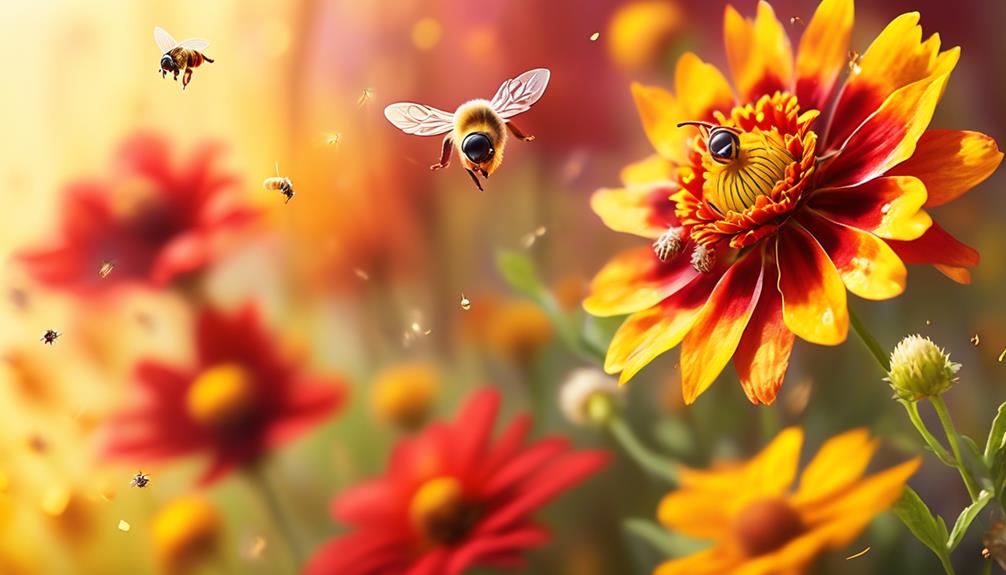
To fully comprehend why bees are drawn to the Blanket Flower, you first need to understand the unique characteristics and attributes of this vibrant plant. Native to North America, this perennial is scientifically known as Gaillardia, in honor of an 18th-century French patron of botany. It's renowned for its brilliant, bi-colored, daisy-like blooms which typically range from red to yellow.
These flowers aren't merely decorative. They're also functional, serving as a nectar and pollen source for various pollinators. The Blanket Flower's bright colors aren't a simple aesthetic feature, they're a visual cue designed to attract bees. You see, bees perceive color differently than humans—they can't see red, but they can detect yellow and ultraviolet, which are dominant in Blanket Flowers.
Moreover, the Blanket Flower's structure facilitates efficient pollination. Its composite flower head is composed of numerous small flowers, or florets, offering bees an abundance of nectar and pollen in a concentrated area. As a bee moves from floret to floret, it inadvertently transfers pollen, aiding in the plant's reproduction. This combination of color, structure, and abundant food supply makes the Blanket Flower an irresistible attraction for bees.
Bees' Natural Preferences Explained
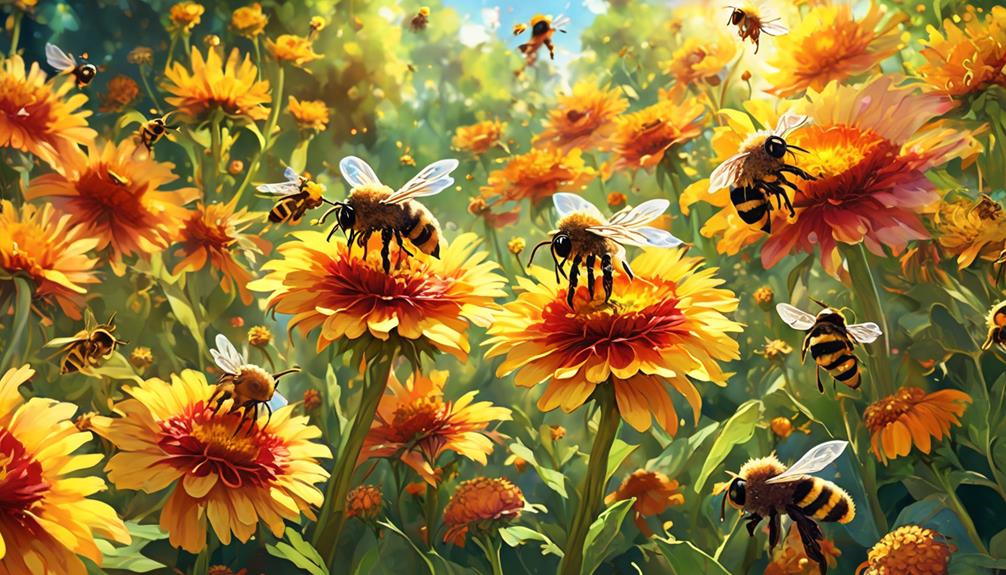
Understanding the natural preferences of bees, you'll find that they're inherently drawn to certain types of plants, including the vibrant blanket flower, due to specific attributes such as color, structure, and nectar availability. These small creatures are not just random in their selection; they're evolved to be strategic pollinators, favoring plants that provide the most nutritional rewards and the best pollen accessibility.
Let's dive into this with a detailed table:
Attribute | Explanation | Impact on Bees' Preference |
|---|---|---|
Color | Bees are attracted to bright colors, especially blue and yellow | Blanket flowers, with their vibrant hues, are highly appealing |
Structure | The flower's shape and size can accommodate bees | Blanket flowers have a flat and broad structure, perfect for bees to land and collect pollen |
Nectar Availability | Bees require nectar for energy | Blanket flowers provide a generous nectar supply |
Pollen Quality | High-protein pollen is essential for bee larvae | Blanket flowers deliver high-quality pollen |
Flower Density | Dense flower clusters mean less energy expenditure for bees | Blanket flowers often grow in dense clusters, reducing the bees' travel time |
Understanding these factors, it becomes clear why bees favor certain plants like the blanket flower. Their preferences aren't arbitrary, but rather a result of millions of years of evolutionary adaptation.
The Appeal of Blanket Flowers to Bees
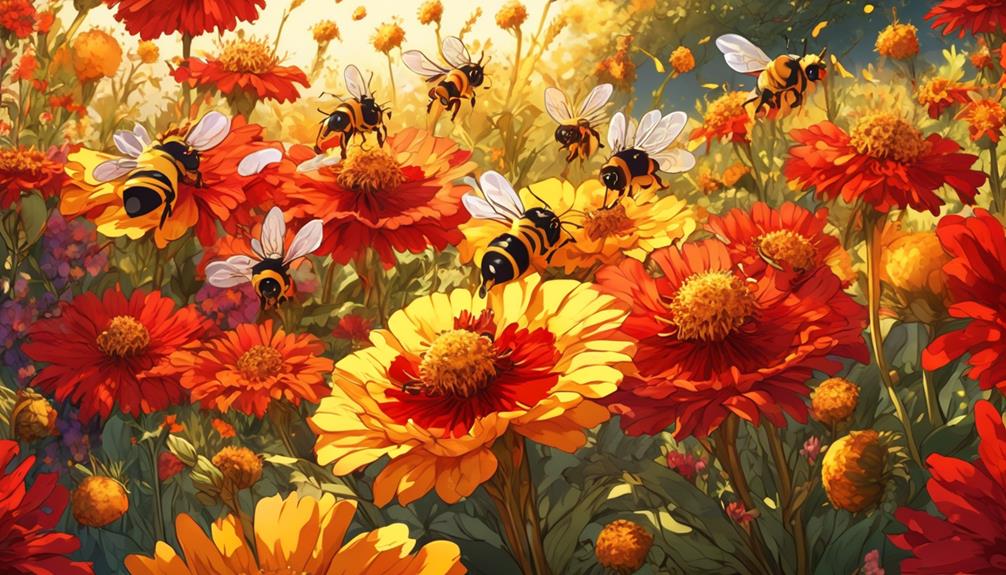
Now that we've explored the factors that influence bees' floral preferences, let's examine why blanket flowers, in particular, are a bee's delight.
Blanket flowers, scientifically known as Gaillardia, are incredibly attractive to bees due to their vibrant colors and rich nectar supply. Their bright, warm hues of red, yellow, and orange act as visual lures, captivating bees' eyes, which are highly sensitive to these colors. It's like a neon sign in a cityscape, impossible for bees to ignore.
On top of their visual appeal, blanket flowers are nectar-rich. Bees rely on nectar for energy and nutrients, and these flowers provide it in abundance. They're like an all-you-can-eat buffet for bees, offering an irresistible feast of high-quality sustenance.
Moreover, the unique structure of blanket flowers facilitates efficient pollen transfer. The flowers' flat, wide petals provide an easy landing platform, while their compact, clustered disc florets enable bees to collect pollen quickly and thoroughly.
Scientific Research on Bees and Blanket Flower
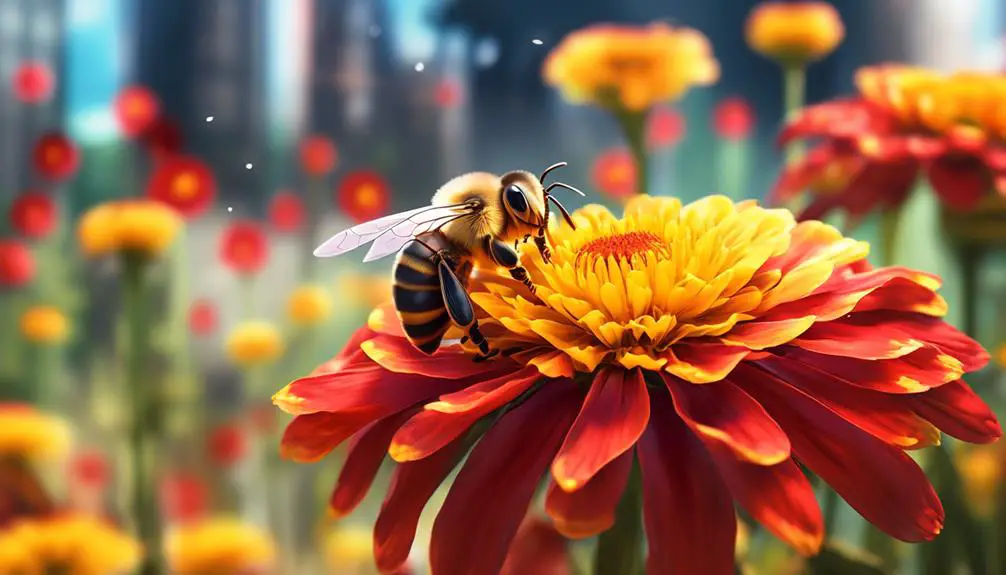
Have you ever wondered what research reveals about the relationship between bees and blanket flowers? Scientific studies have highlighted this fascinating interaction, offering insights into both bee behavior and the characteristics of blanket flowers that attract these pollinators.
You might be intrigued to learn that several studies have found that bees are particularly attracted to blanket flowers. These flowers, owing to their bright colors and high nectar content, act as potent magnets for bees. Research reveals that the Gaillardia genus, to which blanket flowers belong, is among the top ten most visited by bees.
However, it's not just about the allure of the flowers. The bees' attraction also has evolutionary implications. Studies indicate that bees can enhance blanket flower reproduction by facilitating cross-pollination. This symbiotic relationship benefits both parties and contributes to the biodiversity and health of our ecosystems.
Boosting Bee Populations With Blanket Flowers
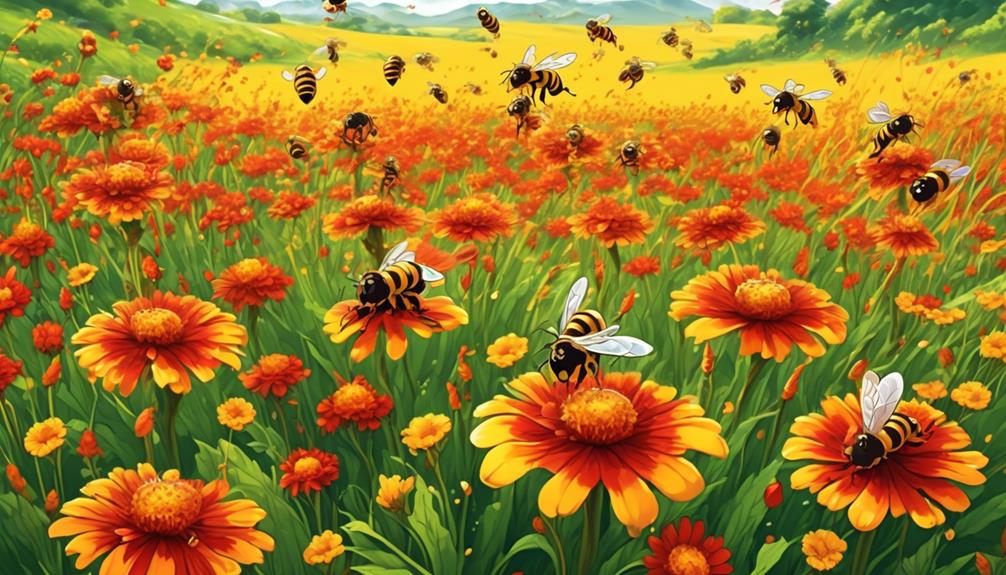
You can play a significant role in boosting bee populations by planting blanket flowers in your garden or local community spaces. Scientifically known as Gaillardia, blanket flowers are nectar-rich and highly attractive to bees, particularly honeybees and native bees.
By introducing these vibrant, easy-to-grow perennials into your landscape, you're creating a food source for bees, thus, promoting their population growth. Bees feed on the nectar and pollen of blanket flowers, deriving critical nutrients essential for their survival and reproduction. Moreover, these flowers bloom from early summer to fall, providing a consistent food supply for bees during these periods.
But let's dig deeper. Your action of planting blanket flowers not only helps in nourishing bees but also aids in their pollination activities. Bees, while collecting nectar and pollen, inadvertently transfer pollen grains from the male anthers to the female stigma of flowers, facilitating cross-pollination. This process is critical for the genetic diversity and sustainability of plant species, including blanket flowers.
In essence, by planting blanket flowers, you're contributing to a virtuous cycle of nature that bolsters bee populations, enhances biodiversity, and maintains the health of our ecosystems.
Frequently Asked Questions
What Other Plants Are Attractive to Bees?
Yes, there are numerous plants that bees find attractive besides the blanket flower. They're particularly drawn to plants such as lavender, sunflowers, and rosemary.
The vibrant colors and sweet nectar of these plants act as a magnet for bees. It's also important to note that bees prefer native plants and those that bloom in the season when they're most active.
How Can I Safely Encourage Bees to Visit My Garden?
Absolutely, you can encourage bees to visit your garden safely.
Start by planting a variety of native plants that bloom at different times, providing nectar throughout the seasons.
Also, avoid using pesticides as they're harmful to bees. Instead, incorporate natural pest control methods.
Additionally, provide a water source, like a birdbath.
Are There Any Potential Risks or Dangers to Bees in Blanket Flowers?
You're on the right track thinking about potential risks to bees. However, there's no need to worry with blanket flowers. They're safe for bees and actually attract them.
They're rich in nectar, providing essential nutrients for our buzzing friends. So, you can plant them without fear. Just ensure they're free from pesticides which can harm bees.
Keep it organic, and you'll be contributing positively to the bee population.
What Are the Benefits of Having Bees in My Garden?
Yes, bees absolutely love blanket flowers! They're attracted to the vibrant colors and rich nectar these flowers produce.
As a bonus, when bees visit your garden, they help pollinate your plants. This means more flowers, fruits, and veggies for you.
So, by planting blanket flowers, you're not only making your garden more beautiful, you're also supporting local bee populations and enhancing your own garden's productivity.
Everyone wins!
How Can I Identify Different Species of Bees?
Sure, you can identify different bee species by observing their physical characteristics. Look at the bee's size, color, and patterns. For instance, honeybees have a golden-brown color with black stripes, while bumblebees are larger, fuzzier, and often have a black and yellow pattern. Carpenter bees are big and black with a shiny, metallic sheen.
Conclusion
In conclusion, bees indeed find the vibrant blanket flower irresistible. This preference stems from the flower's rich nectar stores and pollen supply.
Scientific research confirms this affinity, highlighting the role blanket flowers play in sustaining bee populations.
So, if you're keen on giving these buzzing pollinators a hand, planting blanket flowers in your garden can be a simple, yet effective step towards boosting their numbers and contributing to a healthier ecosystem.

